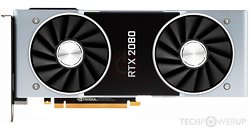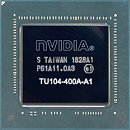Raevenlord
News Editor
- Joined
- Aug 12, 2016
- Messages
- 3,755 (1.24/day)
- Location
- Portugal
| System Name | The Ryzening |
|---|---|
| Processor | AMD Ryzen 9 5900X |
| Motherboard | MSI X570 MAG TOMAHAWK |
| Cooling | Lian Li Galahad 360mm AIO |
| Memory | 32 GB G.Skill Trident Z F4-3733 (4x 8 GB) |
| Video Card(s) | Gigabyte RTX 3070 Ti |
| Storage | Boot: Transcend MTE220S 2TB, Kintson A2000 1TB, Seagate Firewolf Pro 14 TB |
| Display(s) | Acer Nitro VG270UP (1440p 144 Hz IPS) |
| Case | Lian Li O11DX Dynamic White |
| Audio Device(s) | iFi Audio Zen DAC |
| Power Supply | Seasonic Focus+ 750 W |
| Mouse | Cooler Master Masterkeys Lite L |
| Keyboard | Cooler Master Masterkeys Lite L |
| Software | Windows 10 x64 |
A Time Spy benchmark score of one of NVIDIA's upcoming RTX 20-series graphics cards has come out swinging in a new leak. We say "one of NVIDIA's" because we can't say for sure which core configuration this graphics card worked on: the only effective specs we have are the 8 GB of GDDR6 memory working at 14 Gbps, which translates to either NVIDIA's RTX 2070 or RTX 2080 graphics cards. If we were of the betting type, we'd say these scores are likely from an NVIDIA RTX 2080, simply because the performance improvement over the last generation 1080 (which usually scores around the 7,300's) sits pretty at some 36% - more or less what NVIDIA has been doing with their new generation introductions.
The 10,030 points scored in Time Spy by this NVIDIA RTX graphics card brings its performance levels up to GTX 1080 Ti levels, and within spitting distance of the behemoth Titan Xp. This should put to rest questions regarding improved performance in typical (read, non-raytracing) workloads on NVIDIA's upcoming RTX series. It remains to be seen, as it comes to die size, which part of this improvement stems from actual rasterization performance improvements per core, or if this comes only from increased number of execution units (NVIDIA says it doesn't, by the way).



View at TechPowerUp Main Site
The 10,030 points scored in Time Spy by this NVIDIA RTX graphics card brings its performance levels up to GTX 1080 Ti levels, and within spitting distance of the behemoth Titan Xp. This should put to rest questions regarding improved performance in typical (read, non-raytracing) workloads on NVIDIA's upcoming RTX series. It remains to be seen, as it comes to die size, which part of this improvement stems from actual rasterization performance improvements per core, or if this comes only from increased number of execution units (NVIDIA says it doesn't, by the way).



View at TechPowerUp Main Site











